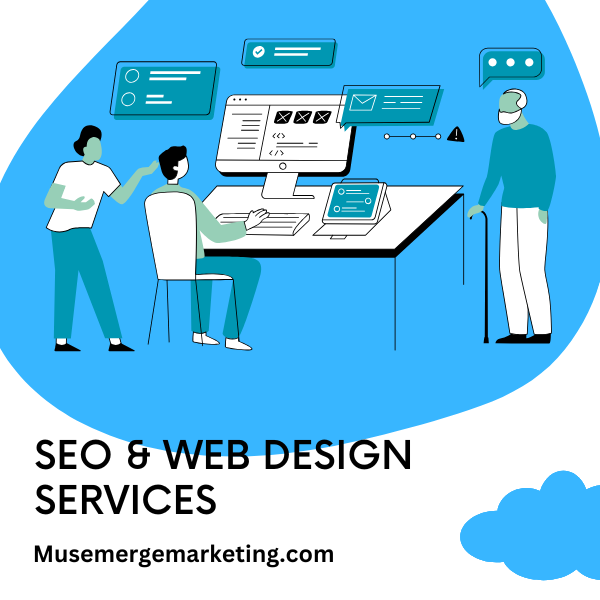Web sesign

Web design plays a crucial role in digital marketing as it directly impacts user experience (UX), conversion rates, and search engine optimization (SEO). In a digital marketing strategy, the web design content should be aligned with business goals, target audience preferences, and overall marketing efforts. Here’s a breakdown of how web design is incorporated into digital marketing:
1. User Experience (UX) Design
- Intuitive Navigation: A clear, easy-to-use navigation menu helps visitors find information quickly, reducing bounce rates and increasing engagement.
- Responsive Design: A mobile-friendly design ensures that users can navigate your site seamlessly across all devices (smartphones, tablets, desktops), which is essential for both user experience and SEO.
- Speed Optimization: A fast-loading website improves user satisfaction and helps rank better on search engines.
2. SEO (Search Engine Optimization)
- On-page SEO Elements: Proper web design ensures the integration of SEO best practices, such as well-structured headings, alt texts for images, clean code, and proper URL formatting. These elements make the website more visible to search engines.
- Mobile Optimization: Google uses mobile-first indexing, meaning that mobile-friendly websites are prioritized in search rankings.
- Content Layout for SEO: Well-organized content with clear headers, bullet points, and keyword-focused text supports SEO by making content easier to crawl and understand for search engines.
3. Conversion Rate Optimization (CRO)
- Call-to-Actions (CTAs): Effective CTAs (e.g., “Sign Up,” “Shop Now”) are strategically placed throughout the website to guide visitors towards taking the desired actions, which directly impact conversions.
- Landing Pages: Custom landing pages with specific offers or campaigns (e.g., lead generation forms or product details) help increase conversions by focusing on targeted content.
- Visual Hierarchy: A good web design places emphasis on the most important elements like CTAs, product offers, and contact forms, encouraging users to take action.
4. Brand Consistency
- Design Aesthetic: Consistent branding (colors, logos, fonts) creates a cohesive experience across all digital platforms, helping build brand recognition and trust.
- Tone and Messaging: The design should reflect the brand’s tone and messaging, ensuring that users feel connected to the company’s identity.
5. Content Strategy
- Content Placement: Effective web design organizes content in a way that is easy to read and digest. It includes placing high-quality images, videos, blogs, and other media to engage visitors.
- Storytelling: Content should tell a story that resonates with the target audience. Web design must facilitate this through structured sections, visuals, and compelling content that communicates your brand’s message.
6. Analytics and Tracking
- Tracking User Behavior: With the right web design, businesses can implement tracking tools like Google Analytics and heatmaps. This data helps improve marketing strategies by understanding how users interact with the site.
- A/B Testing: Web design supports A/B testing by allowing variations of content and design to be tested, helping marketers refine user experience and conversion strategies.
7. E-Commerce Integration (for E-Commerce Businesses)
- Product Pages: Clear, appealing product pages with detailed descriptions, pricing, and high-quality images encourage purchases.
- Smooth Checkout Process: An optimized, user-friendly checkout process reduces cart abandonment, which is critical for online sales.
8. Content Management System (CMS)
- Easy Updates: A well-designed website using a CMS like WordPress or Shopify allows businesses to update content (like blog posts, offers, and product listings) without needing advanced technical skills.
- SEO-Friendly CMS: Some CMS platforms are designed with built-in SEO features, making it easier for businesses to implement SEO best practices.
9. Social Media Integration
- Share Buttons: Adding social media buttons to blog posts and product pages helps visitors share content, driving traffic and increasing brand awareness.
- Embedding Feeds: Incorporating social media feeds (e.g., Instagram or Twitter) into the website creates social proof and keeps content dynamic and up-to-date.
10. Security and Trust Signals
- SSL Certificates: Secure websites (indicated by “https”) build trust with visitors and are essential for SEO rankings.
- Trust Badges: Displaying trust signals like secure payment options, customer reviews, or industry certifications can increase credibility and boost conversion rates.
11. Content Marketing Integration
- Blog Section: Regular blog updates help engage users, improve SEO rankings, and establish authority within the industry.
- Multimedia Content: Incorporating videos, infographics, and podcasts makes the website more engaging and boosts user retention.
In summary, web design is more than just the visual appearance of a website. It should be strategically planned to support digital marketing efforts, enhance user experience, improve SEO, increase conversions, and ultimately drive business growth